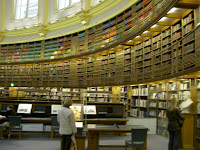Alright, I guess my passion to visit museum and spend hours appreciating the exhibits is rekindled during my stay in London. In fact, close to Imperial College, there are 3 museums - Science Museum, Natural History Museum and Victoria & Albert Art Museum. But in this entry, I would like to talk about the famous British Museum that I made two seperate trips.
Location
The easiest way to reach the British Museum is by taking the tube to Tottenham Court Road and walk along New Oxford Street and make a left turn at Coptic Street into Great Russell Street. I have used Goggle Map to locate British Museum for my blog reader. See, I treat you so nice... so.. leave some comment here. ;)
The entrance
The Roman-Greek pillars and triangle roof-top at the entrance to British Museum is a famous spot for photograph. To know about the history and the details of British Museum, see wikipedia entry http://en.wikipedia.org/wiki/British_Museum. In fact, the British Museum is free since 1753 and has an extensive collection of human cultural history. Most of the collections are "obtained" during the great Victoria Era where there is sunlight all day long in one part of her extensive colonies. Even though it is free, at the entrance there is donation boxes for generous visitors. So, are you generous tourist? Hehehe....
Left: Late winter visit to British Museum
Right: British Museum entrance with roman-greek pillars.
Paul Hamlyn Library
At the centre of the museum is the awesome Paul Hamlyn Library with 20-25,000 books and journals from a wide range of subject-matter that are meant to educate the visitors on the exhibits of the museum. The books are never allowed to be borrowed out and can only referenced during its opening time. Walking into this museum would surely amaze you with the way these collection of books are systematically arranged on the multi-tiers bookshelves in-built around the walls. Check out the photos I took below:
Left: Bookshelves circumfering the round library
Right:The bookshelves are multi-tiers
Ancient Egyptian
British Museum has the most extensive collection of ancient Egyptian artifacts outside of Cairo, Egypt. In my opinion, except the great pyramid of Gaza and Sphinx, British Museum has it all.
What could be more interesting than trying to decipher the language scripts crafted on the Rosetta Stone in hieroglyphic, demotic and ancient Greek? The text on the stone is actually a decree from Ptolemy V (Egypt King) instructing the erection of statues in temples and repealling of various taxes. See wikipedia entry at http://en.wikipedia.org/wiki/Rosetta_Stone.
Left: Rosseta Stone Right: Statue of Ramesses II
Man-horse statues guarding the entrance to Egypt Collection
Ancient Egytian Wall Painting
Still remember the Mummy Return? British Museum is the place to go if you are keen in understanding the burial ceremony of Egytian Royalty. The artifacts displayed here are simply excellent beyong words though it is an irony to find such extensive collection outside Egypt. Well, personally, a slow stroll around the showcases are informative as well as eye-opener. The procedures and techniques used in mummification awed me in many ways.
African Art
Being the first time to expose myself to African art, I found them amazingly creative despite the level of high illiteracy in the continent. Among the many artworks displayed, the "arm chair" drew the most attention out of me. I could understand the meaning behind - "Guns are so common in African until there are spare ones sufficient to make warlord's chair". Surely, many scenes of bloody scenes flash in my mind ... Blood Diamond ...
Misc
Sadly, not many photos were taken during my trip to British Museum as I was too engrossed in reading the description of each exhibit. Ha ha ... believe me ? ;)
Left: A mixture of ultra-modern roof and roman facade
Right: The dish thrower


















2 comments:
Wah seh so many travellings!!!! You full time traveller is it???
Haha... how I wish. Maybe when I work I think about travelling all the time
Post a Comment